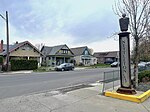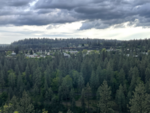Latah Creek

Latah Creek ( LAY-tə), also known as Hangman Creek, is a large stream in eastern Washington and north central Idaho in the United States. The creek flows northwest from the Rocky Mountains to Spokane, where it empties into the Spokane River. It drains 673 square miles (1,740 km2) in parts of Benewah and Kootenai counties in Idaho, Spokane County and a small portion of Whitman County in Washington, where over 64 percent of its watershed resides. Some major tributaries of the approximately 60-mile (97 km) creek include Little Latah Creek (also known as Little Hangman Creek) and Rock Creek. The average flow of the creek can range from 20 cubic feet per second (0.57 m3/s) to 20,000 cubic feet per second (570 m3/s). Latah Creek receives its name from a Nez Perce word likely meaning "fish". In 1854, the creek received another name, Hangman Creek, from a war between the Palouse Indians and white soldiers, which resulted in several Palouse being hanged alongside the creek. The Latah Creek watershed is dominated by agriculture, which has released large amounts of sediment from the surrounding Palouse soils into the watershed on an annual basis. This has caused the ruin of natural fish populations, riparian zones, and natural flow patterns. The creek has been channelized in some places, and meanders, islands and natural channel formations have been destroyed. In response to these damaging factors, the water quality overall in the Latah Creek basin is quite low, and "Washington State water quality standards for temperature, dissolved oxygen, pH, and fecal coliforms are routinely violated." The remaining third of the land in the watershed is mostly forest.
Excerpt from the Wikipedia article Latah Creek (License: CC BY-SA 3.0, Authors, Images).Latah Creek
Sandifur Bridge, Spokane
Geographical coordinates (GPS) Address Nearby Places Show on map
Geographical coordinates (GPS)
| Latitude | Longitude |
|---|---|
| N 47.66 ° | E -117.45777777778 ° |
Address
Sandifur Bridge
Sandifur Bridge
99201 Spokane
Washington, United States
Open on Google Maps










